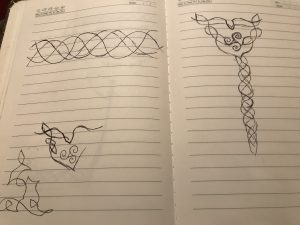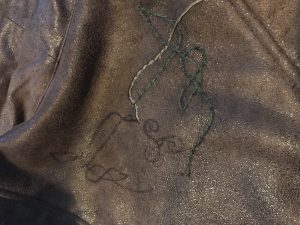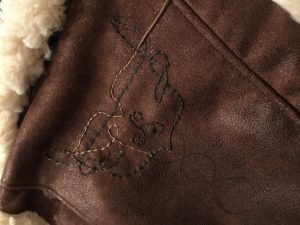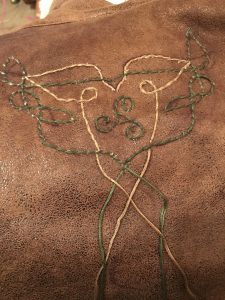This weekend, I was meant to attend a wool felting workshop at a local farm using wool from their heritage breed sheep (a breed originating in the British Isles), but unfortunately the event was canceled at the last minute. Felting happens to be one of the oldest forms of textile art found in Ireland, so I was incredibly disappointed to have missed the opportunity to learn a bit more about the art. But, I improvised and still completed some hands-on work with an art that I had a bit more experience with.
I began by reading the book Contemporary Irish Textile Art: The Women of Annaghmakerrig, small anthology of textile art done by women of different backgrounds at the Tyrone Guthrie center. The book shows pictures of the women’s work alongside explanations of the history behind different techniques and inspiration used in each piece. I was particularly inspired by the decorative stitching used in many of the pieces, as well as the themes of knotwork that were present. With this inspiration in mind, I decided to try my own hand at decorative stitching in the form of Celtic knotwork.
(some very messy freehand drafting of knot work patterns)
I chose a faux sheepskin vest that I had thrifted the week before and began drafting a pattern to follow on the back of it. It seemed appropriate for me to transform something that was originally created to be worn a few times and then disposed of into a piece of wearable art (a concept called “upcycling” that I’ll be looking into more over the next 10 weeks). Over the course of the weekend, I dedicated roughly 12 hours to drafting and sewing and not too surprisingly only barely scratched the surface of the vision I have in mind for the piece.
(Progress after drafting the main knotwork piece – about three hours in.)
The Women of Annaghmakerrig talked of the hours of solitude that is often accompanied by hand-rendered textile art. That is an experience that I have not been unfamiliar with in the past, however this weekend it was particularly poignant. As I was locked in my room, completely absorbed in the work I was doing while the hours flew by, I thought a good deal about the transformation of these crafts into social scenes for women of the Irish islands. I thought about the spinning circle that I attended myself when I was in Ireland earlier this year and the quiet presence that everybody enjoyed while absorbed in their own craft. This experience made it even clearer why those arts were able to endure through the industrial era and onto modern times. The shared culture and vision of people together but separately working on their own artistic vision does make for a very enjoyable and very nearly meditative experience that machines cannot replace.
(Progress as the weekend came to a close – almost done with the centerpiece at 12 hours in)
My lack of expertise in the area of hand-stitching was definitely responsible for the amount of time it took me to get the measurements of the design just right. However, even if I had more practice and was able to cut the production time in half, the amount of labour involved in the finished design that I have in mind would likely put the price of this garment at well over $200 in order for me to hypothetically make a living wage off of this particular art. As I continue to hypothesize about and participate in hand rendered crafts, I will keep the hours of labour and pricing in mind.
(the completed main piece after putting a couple more hours into it)



